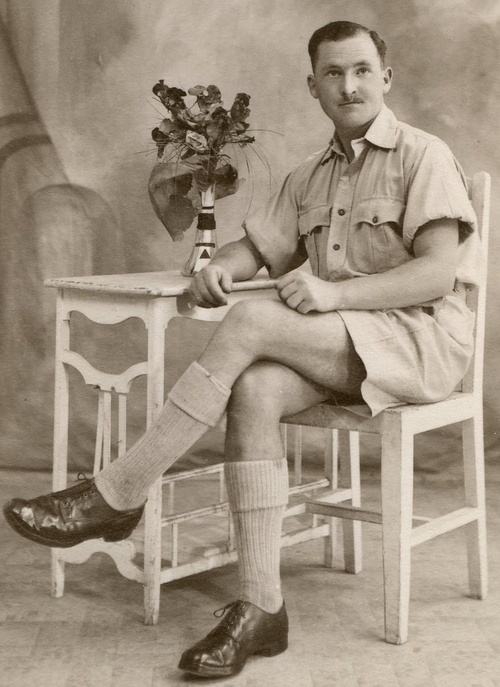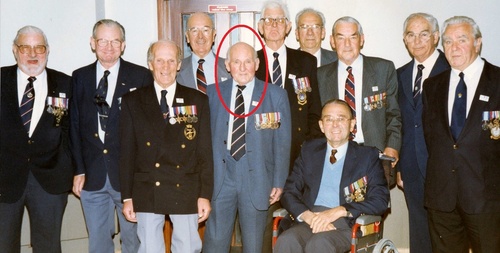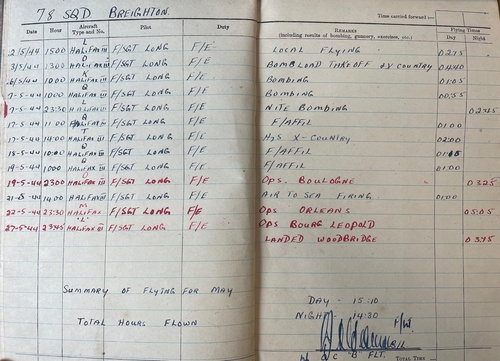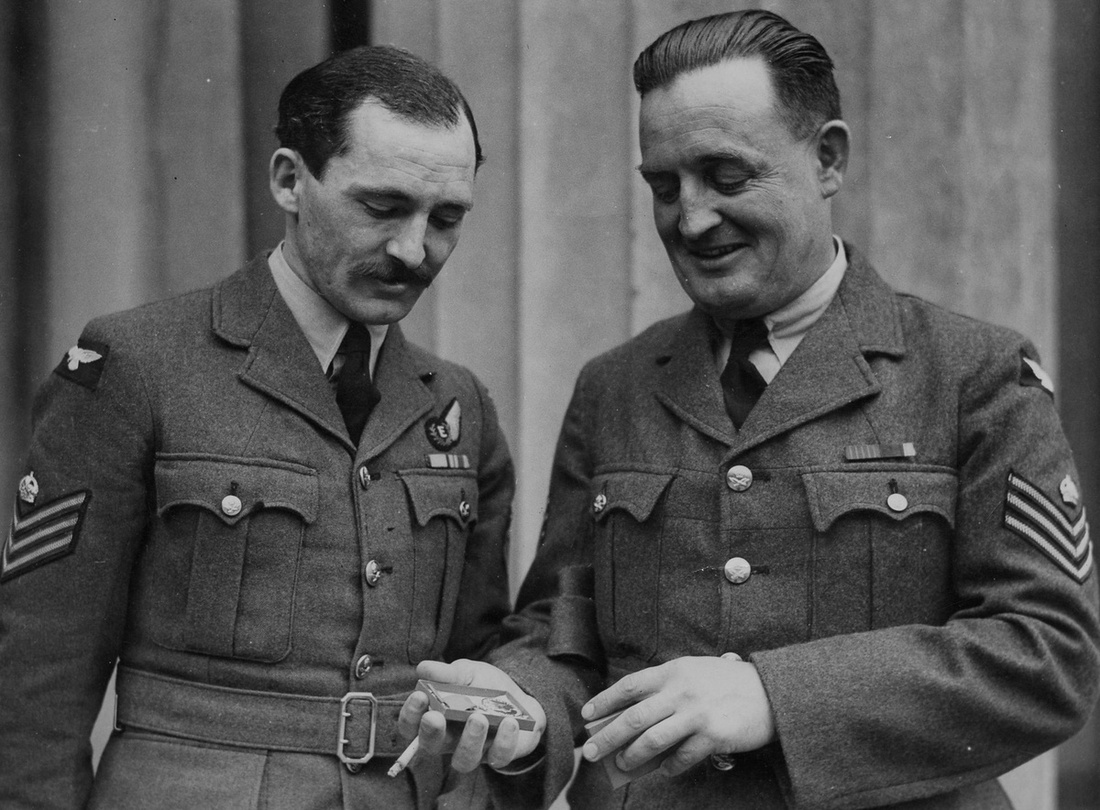Auction: 22003 - Orders, Decorations and Medals
Lot: 479
Sold by Order of a Direct Descendant
'Before we could operate extinguishers we were attacked again. Browne was badly injured in right elbow and I was hit in right arm, buttock, and explosion in right foot - like standing in molten metal. We lost height in a spiral - starboard motor cut which allowed control to be regained but now great loss of height. Still on fire - I was now joined by Sergeant Low mid upper whose turret was damaged and ammunition exploded. Browne had returned to his radio which was damaged. Eventually fire extinguished but aiming extinguisher fluid against slip-stream without emergency oxygen caused inhalation and very sore eyes.'
The man himself on the hair-raising events of 27 May 1944.
The superb and rare Second War 1944 'Immediate' C.G.M. (Flying) group of seven to Warrant Officer F. B. 'Dusty' Dew, No. 78 Squadron, Royal Air Force Volunteer Reserve, whose Halifax was thrice attacked by an enemy fighter when returning from a raid on Bourg Leopold on 27 May 1944; on that fateful night Dew received severe wounds to his foot, thigh and arms and was losing a dangerous amount of blood; in spite of this he selflessly went to extinguish dangerous fires which had broken out in their aircraft and even put one starboard engine back into action; despite the fact he was rendered unable to move due to his wounds, he inspired those around him and directed other members of the Crew to carry out the duties of Flight Engineer and got them home - his right foot was so badly damaged it was amputated as a result
Conspicuous Gallantry Medal (Flying), G.VI.R. (1210365. Sgt. F. B. Dew. R.A.F.); 1939-1945 Star; Air Crew Europe Star, clasp, France and Germany; Africa Star; Defence and War Medals 1939-45; Malta George Cross 50th Anniversary Medal, mounted court-style as worn, extremely fine (7)
Previously sold on behalf of the family in these rooms in July 2009, when purchased by his daughter, Mary, who offers a few words on her late father:
'I am immensely proud of my late father "Dusty" Dew and the actions he took to ensure that Halifax 'L' Lima returned with its surviving crew to Woodbridge that fateful night.
In his later years he spent much of his time tracking down fellow recipients of the C.G.M. (Flying), and he managed to contact over one hundred of those who lived to tell the tale.
His injuries sustained meant many trips to Roehampton to have his prosthetic leg maintained and updated before his death in 1995. He was a great supporter of the Bomber Command Memorial but unfortunately passed before its completion. I was pleased to purchase the Medals in 2009 to them to keep them in the immmediate family, but I have reluctantly decided to sell them - feeling they should be with a specialist collector rather than gathering dust in a drawer in our house.'.
Just 109 awards of the C.G.M. (Flying) were made during the Second World War, 82 of these to the Royal Air Force.
C.G.M. London Gazette 7 July 1944 - when listed jointly Flight Sergeant Kenneth Lawrence Long and Sergeant Ladislaus Corbishley Browne, both awarded the D.F.M. for their actions:
'These airmen were flight engineer, pilot and wireless operator (air) of an aircraft detailed to attack Bourg Leopold one night in May, 1944. When nearing the enemy coast, on the homeward flight, the aircraft was attacked by a fighter and sustained considerable damage. Two engines were put out of action and extensive fires started in the fuselage. The bomber temporarily went out of control. At this moment it was struck by bullets from another enemy aircraft.
Sergeant Dew was badly wounded in the foot, the thigh and arm; Sergeant Browne also sustained severe wounds in the arm and thigh. The situation was critical but although Sergeant Long ordered his crew to prepare to abandon aircraft, he attempted to regain control. He succeeded in so doing. Meanwhile, Sergeant Dew, in spite of considerable suffering and weakness through loss of blood, fought the fires and his efforts were successful; he also succeeded in re-starting one of the damaged engines. By now he was unable to move about.
Nevertheless, throughout the remainder of the homeward flight he directed other of his comrades in the necessary engineering tasks. Sergeant Browne also proved himself to be a devoted member of aircraft crew for, injured as he was, and suffering acutely, he insisted on remaining by his wireless apparatus to assist his pilot on his course. Eventually, Flight Sergeant Long reached an airfield in this country and made a safe landing. In the face of a trying ordeal, these airmen displayed high courage, great skill and endurance. Their example ranks high.'
The Recommendation, dated 31 May 1944, states:
'On the night of 27 May 1944, Sergeant Dew was the Flight Engineer of a Halifax bomber which took part in the attack on Bourg Leopold. Returning over the enemy coast, the bomber was attacked three times by an enemy fighter. Extensive fires were started in the bomb bays and fuselage, the fuel supply to both starboard engines cut and Sergeant Dew received severe foot, thigh, and arm wounds. Completely disregarding his own intense physical suffering and weakness through loss of blood, Sergeant Dew extinguished the fires and succeeded in putting one starboard engine in action again. For the remainder of the return flight, although in great pain and unable to move about, he directed other members of the crew in Flight Engineer duties.
His right foot was amputated after landing in England. By his skill, courage, and dogged determination, this N.C.O. extricated his crew from a perilous situation and contributed materially to the safe return of his aircraft. I consider that his devotion to duty and gallant conduct fully merit the award of the Conspicuous Gallantry Medal (Flying).'
Remarks by Station Commander:
'This N.C.O., on the night of 27 May 1944, displayed courageous qualities in keeping with the finest traditions of the Service. In spite of intense physical suffering through wounds, he rose to the occasion with dogged determination and stuck to his post. The successful completion of the operational sortie was largely due to Sergeant Dew's commendable courage and devotion to duty. I strongly recommend that the outstanding qualities of courage and devotion to duty displayed by this N.C.O. should be recognised by the immediate award of the Conspicuous Gallantry Medal (Flying).'
Remarks by Air Officer Commanding:
'This Flight Engineer showed great courage and devotion to duty on the night of 27 May 1944, and I strongly recommend the immediate award of the Conspicuous Gallantry Medal (Flying).'
Fielder Bennett Dew - or 'Dusty' to his friends and comrades - was born on 5 January 1920 at Kingstone, Hereford, the youngest son of Mr. and Mrs. T. J. Dew and was educated at Hereford Cathedral School and Dean Close School, Cheltenham, where he was a keen hockey player. On leaving school he joined the Ford works at Dagenham as an engineering student and, although working in a reserved occupation, enlisted in the Royal Air Force Volunteer Reserve on 15 November 1940.
Having promised his father that he would not fly, he served on the ground staff at Malta throughout the aerial siege (Africa Star). Following his father's death in 1942, Dew volunteered for aircrew duties and having been promoted Temporary Sergeant in January 1944, returned to England for training as a Flight Engineer in the spring of 1944. Posted to No. 78 Squadron at Breighton operating Halifaxes, his first Op was on Boulogne on 19 May 1944, followed by a raid on Orleans three days later, and then the raid on Bourg Leopold on 27 May 1944.
The best person to describe the events is the man himself:
'The events of this flight might have been very different had it not been for a premonition. I feared the worst. Replacement Rear Gunner - bad omen. Upon calculating the bomb and fuel load I decided to request 360 extra gallons of fuel to be added within all-up-weight for take off. We took off at 12:16 am and were told to look at Woodbridge emergency landing ground as we passed over. Uneventful trip - bombed at 2:15 am from 11,000 feet and headed for home.
We were severely attacked for a sustained period and substantially damaged, probably from below. Fire from aft of rear spar to rear turret. Order from Flight Sergeant Long "Prepare to bale-out." I asked to try to extinguish fire - we were still level flight. Permission given, I was joined by the Wireless Operator Sergeant Brown. Before we could operate extinguishers we were attacked again. Browne was badly injured in right elbow and I was hit in right arm, buttock, and explosion in right foot - like standing in molten metal. We lost height in a spiral - starboard motor cut which allowed control to be regained but now great loss of height. Still on fire - I was now joined by Sergeant Low mid upper whose turret was damaged and ammunition exploded. Browne had returned to his radio which was damaged. Eventually fire extinguished but aiming extinguisher fluid against slip-stream without emergency oxygen caused inhalation and very sore eyes.
We could not maintain height on two engines because of extra drag caused by severe damage to airframe. The navigation equipment driven by starboard engine was out of action, and no radio - had to rely on sextant for navigation. Knowing we still had 180 gallons of fuel I advocated heading for home instead of bailing out, and possibly ditching in the Channel. By opening main balance we could start starboard inner engine and gain height. Browne was able to repair radio and obtain fixes and Flying Officer Chiverton's efforts brought us accurately to Woodbridge.
Now to get down! It was imperative to have three engines to land but to open the main balance was not only dangerous but forbidden. Any slight deviation from level flight would cause an air lock and all motors would cut. This was agreed and understood. Risk anything by now. Fortunately in spite of extensive damage wheels came down and everything essential seemed to work. We landed safely, with emergency tenders rushing along side.'
Flight Sergeant Long's own account of events differs slightly, and clarifies a number of points. Having given the order to bale-out, he was informed over the intercom by the Navigator that they were currently over water. He countermanded the order, and turned the plane around to head back to the Continent to give his crew a chance to bale-out. Sergeant Bell, the Bomb-Aimer, did not hear this second order, and baled out over the sea, eventually being washed ashore two weeks later. The enemy aircraft attacked a second time, and the wounds sustained by the crew prevented them from jumping. Long then remarked 'We'll have a shot at trying to get out of this mess', and headed for home, fully expecting to have to ditch in the Channel, not being aware of the extra fuel that the plane was carrying.
Dew's injuries were severe upon their crash landing at Woodbridge. He was transferred to the Royal Air Force Hospital at Ely where he spent the next two and a half years. Gangrene was anticipated because of burns, frostbite, and general muck picked up as he had hobbled around the aircraft on a mutilated foot, and as a result his right foot was amputated. His arm injury reduced his right hand to a clenched fist and it was only orthopaedic nerve surgery with rabbit tendons being grafted that some semblance of normality was restored. Nonetheless he was invested with his richly-deserved Conspicuous Gallantry Medal by The King at Buckingham Palace on 31 July 1945.
Promoted Temporary Warrant Officer on 24 January 1946, he was discharged, as a result of his injuries, on 15 October 1946, and embarked upon a career in the motor industry, working in sales and management.
The C.G.M. lay, never mentioned and almost forgotten, in its presentation box in a dressing table drawer for almost half a century. Fate intervened when a letter sent to his 1944 address arrived in 1992. It came from an enthusiast collecting signatures. Somewhat puzzled, Dew granted the request and asked about the interest in and significance of the award. Never having met or heard of another C.G.M. (Flying) recipient, he wondered whether there were others like him and set out on a quest that absorbed the remaining years of his life. Ultimately he found 40 recipients still living, met most of them and organised a muster of 14. Only 18 had eluded trace by the time of his death. This small band of airmen was welcomed into their own section of the Gallantry Medal League as a result of his efforts and he was privileged to represent them at the Cenotaph in November 1994 only weeks before his death in January 1995.
Sold together with the following original archive:
(i)
His Navigator's, Air Bomber's and Air Gunner's Flying Log Book, covering his entire flying career, 4 March-27 May 1944.
(ii)
Copy of the recipient's account of the Bourg Leopold Raid, with additional comments from the Pilot, Flight Sergeant K.L. Long, D.F.M.
(iii)
Telegram to the recipient informing him of the award of the C.G.M., dated 1 June 1944, from the Officer Commanding, No. 78 Squadron.
(iv)
Letter to the recipient from the Central Chancery regarding the investiture of the C.G.M., dated 24 July 1945
(v)
Letter to the recipient from Mrs. Dorothy Law, mother of one of his crew-mates, dated 6 June 1944.
(vi)
The recipient's Royal Air Force Flying Clothing Card and List of Phrases booklet.
(vii)
Telegram to Mrs. T.B. Dew, the recipient's sister-in-law, informing her of Dew's serious injury, dated 28 May 1944.
(viii)
Copy of the recipient's certificate of discharge, together with various newspaper cuttings regarding the award of the C.G.M., photographs of the recipient, including one after the investiture, and one with fellow C.G.M. holders.
Subject to 20% VAT on Buyer’s Premium. For more information please view Terms and Conditions for Buyers.
Sold for
£18,000
Starting price
£15000















